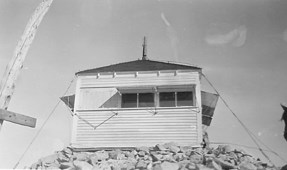An Alberta fire lookout on top of a giant had its operations cut out from underneath it in 1950 after over two decades of service. The Black Rock Fire Lookout had been a prominent location for the Alberta fire detection system from 1928-50.
An Alberta fire lookout on top of a giant had its operations cut out from underneath it in 1950 after over two decades of service.
The Black Rock Fire Lookout had been a prominent location for the Alberta fire detection system from 1928-50.
Nearly seven decades later the aged, unused and lonely structure that has stood through time and mountaintop elements is being considered for historic landmark status.
Municipal District of Bighorn council unanimously approved to apply for the lookout to be potentially designated as a Provincial Historic Resource at its regular meeting on July 12.
“(On July 4), we received an email from Alberta Culture and Tourism and have had ongoing discussions about how to protect sites on Crown land,” said Rob Ellis, MD director of planning services.
The MD's Heritage Resources Committee (HRC) submitted an inventory list of Crown land sites within the MD to Alberta Culture that could potentially become protected.
Alberta Culture evaluated the inventory and invited HRC to nominate the wooden lookout on the peak of Black Rock Mountain to become a historic resource through an application process.
Once submitted, it is expected to take 12 to 16 months to determine its status.
Ellis is considering hiring a heritage consultant for $1,000 to assist in the application process.
The financial implications for a consultant, if any, have already been allocated in the MD's HRC budget.
Lynda Grischkat, chair of HRC, is proud of where the MD has taken its heritage inventory items from the start of the process a decade ago to the point where sites are becoming designated and up for consideration.
“A lot of things are quickly disappearing,” she said. “We're a very young MD, just over 25 years old, so to be able to move forward and see some of these sites are protected ... I think it's important to preserve these things for the future.
“If they designate a historical resource, it's protected and maintained by the provincial government.”
Lookouts serve as a vital part of Alberta's fire detection system and the Black Rock Lookout helped with development of the forest industry and forest fire protection in the MD of Bighorn.
The wooden hut had windows and a panoramic view for ease in detecting wildfires such as in the Ghost River and Waiparous Creek Valley.
Built in 1928 on Black Rock Mountain and hugging the eastern edge of the Rockies about 40 kilometres north of Exshaw on Crown land, the materials to build the lookout were hauled to the site by horse and mule pack trains, said Ellis.
“The 12-foot-square structure was situated at the very crest of the mountain, in what is described as a rocky, austere alpine setting,” said Ellis.
The one-storey wooden structure with a pyramid-style roof served from its inception to 1950, when a section of the trail that led to the lookout had crumbled.
Due to this, the lookout was abandoned in favour of a more accessible lookout - Mockingbird Hill Fire Lookout, east of Black Rock Mountain.
It's been alone on the mountain's summit for 66 years since it was abandoned, and the Black Rock structure sits as an obsolete relic after serving its purpose for the MD and Alberta.
Erik Butters was the first council member to verbally support the application to nominate the Black Rock Fire Lookout.
“As far as I can tell there is no cost to Bighorn and no downside for Bighorn,” Butters said.
Reeve Dene Cooper spoke to the upside of the application process and nomination.
“This is a long-term artifact ... Visitors need to be reminded of its history,” said Cooper.
The Black Rock Lookout was the second highest of the first generation of lookouts (2,463 metres above sea level).
It was used for surveillance only and was known as a “lookout cupola.” No one would have lived on site.
Black Rock's elevation often worked against the lookout, though, because cloudy or stormy weather would obscure the observer's view.
When wildfires were raging through the land, a hawk-eyed observer would use a radio to report the blistering flames.
In 1996, Black Rock Lookout was slightly renovated when shingles on the roof and sides of the structure were replaced.
The inventory list and the good news about that, said Grischkat, is a “great accomplishment” for the HRC and MD.
“The rest of our heritage inventory items are going on the Province's listing of historical places ... that doesn't mean they're designated, but they're flagged for consideration,” said Grischkat.
Accessing the fire lookout is an approximate nine-kilometre hike along an old horse trail to the summit of Black Rock Mountain.
